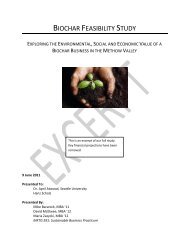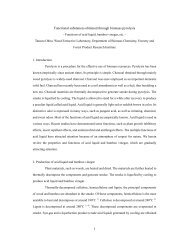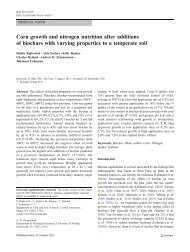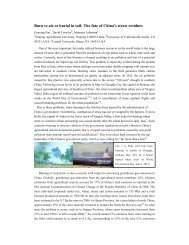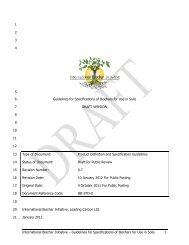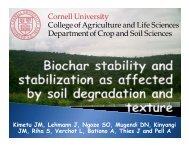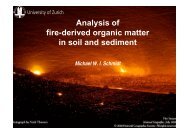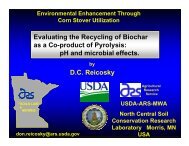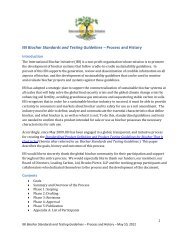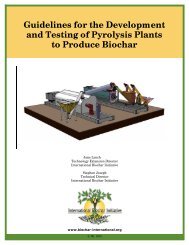Guidelines on Practical Aspects of Biochar Application to Field Soil ...
Guidelines on Practical Aspects of Biochar Application to Field Soil ...
Guidelines on Practical Aspects of Biochar Application to Field Soil ...
- No tags were found...
Create successful ePaper yourself
Turn your PDF publications into a flip-book with our unique Google optimized e-Paper software.
4.5.2 Localized applicati<strong>on</strong><strong>Biochar</strong> could be applied in planting holes before transplanting trees and other plants, asmenti<strong>on</strong>ed above.4.5.3 Applicati<strong>on</strong> in structural layers while c<strong>on</strong>structing golf greens<strong>Biochar</strong> could potentially be applied in layers below the rooting z<strong>on</strong>e <strong>of</strong> grass, <strong>to</strong> serve as abarrier for leached nutrients and pesticides. In many cases such layers would need <strong>to</strong> <strong>of</strong>feradequate drainage and not cause waterlogged c<strong>on</strong>diti<strong>on</strong>s above them, and this can likelybe managed with the particle size <strong>of</strong> the biochar. More research is required <strong>to</strong> verify thesepotential benefits and determine best management practices.4.5.4 Applicati<strong>on</strong> <strong>to</strong> turf aerati<strong>on</strong> holesA 1943 report states that biochar was successfully applied <strong>to</strong> aerati<strong>on</strong> holes made inestablished turfgrass, using a home-made handheld device which delivered biochar in<strong>to</strong>the aerati<strong>on</strong> holes made by other equipment. Using a very fine material (passing a 0.6 mmsieve), applicati<strong>on</strong> rates equivalent <strong>to</strong> 3.9-5.4 t/ha were achieved (Secti<strong>on</strong>, 1943, Dec).4.6 Carb<strong>on</strong>-sequestering art work in the landscapeCarb<strong>on</strong>-sequestering designs made with biochar and other materials have been proposedfor parks, arboreta, or other locati<strong>on</strong>s. Two-dimensi<strong>on</strong>al designs in the landscape must beplaced <strong>on</strong> a slope for viewers who are <strong>on</strong> foot <strong>to</strong> appreciate, and actual projects areneeded <strong>to</strong> test ways <strong>of</strong> c<strong>on</strong>taining biochar and protecting it from surface run<strong>of</strong>f with rain orwind erosi<strong>on</strong>. Alternatively, large designs could be made <strong>on</strong> flat terrain with the goal <strong>of</strong>being seen from airplanes, for example in deserted areas. Such designs have the potential<strong>to</strong> serve as good <strong>to</strong>ols for educating the public about C sequestrati<strong>on</strong> with biochar.4.7 Degraded area reclamati<strong>on</strong> and watershed managementEach degraded or c<strong>on</strong>taminated area in need <strong>of</strong> reclamati<strong>on</strong> is potentially unique. <strong>Biochar</strong>has the potential <strong>to</strong> facilitate the establishment <strong>of</strong> vegetati<strong>on</strong> <strong>on</strong> such soils, while sorbing avariety <strong>of</strong> heavy metals (Mohan et al., 2007; Cao et al., 2009), organic compounds (Keechet al., 2005; MacKenzie and DeLuca, 2006; Smernik, 2009), and pesticides (Wang et al.,2006; Spokas et al., 2009).For degraded area reclamati<strong>on</strong>, depending <strong>on</strong> the objectives and c<strong>on</strong>straints <strong>of</strong> a givenarea, any <strong>of</strong> the techniques above can be c<strong>on</strong>sidered. <strong>Biochar</strong> could also be used <strong>to</strong> “trap”nutrients or other pollutants in strips near waterways, or even directly inside streams or atthe outlet <strong>of</strong> drainage ditches. Opti<strong>on</strong>s for engineering trapping systems with biochar arenumerous and require investigati<strong>on</strong>.5. C<strong>on</strong>clusi<strong>on</strong>sJust as potential benefits deriving from applying biochar <strong>to</strong> soil are numerous, so are soilmanagement systems in which biochar could be incorporated. Farmers and gardeners<str<strong>on</strong>g>Guidelines</str<strong>on</strong>g> for <strong>Biochar</strong> Applicati<strong>on</strong> <strong>to</strong> <strong>Soil</strong>—Internati<strong>on</strong>al <strong>Biochar</strong> Initiative Page 19



